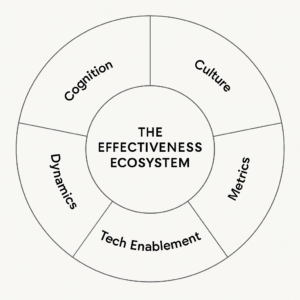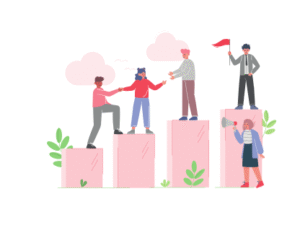Effectiveness Is Not What You Think It Is
A casual discussion with a senior HR leader at a global tech firm took a surprising turn. They said “Our top performers are burning out… and some of our most grounded people are getting overlooked.”
It struck a chord. Because somewhere along the way, the corporate world equated effectiveness with volume. More emails, frequent meetings and increased visibility. But is that really what drives impact?
Not necessarily. In fact, research from the Harvard Business Review suggests that some of the most quietly effective employees are the ones who ask better questions, declutter workflows and bring calm to chaos. They are not always loud. But they are unmistakably valuable.
So, what if our definition of effectiveness is outdated? What if we are rewarding noise over nuance?
This is where we need to pause, rethink and redesign.
The Effectiveness Ecosystem
Effectiveness is not a trait. It is a system. One that needs deliberate design.
Think of it like a forest. A thriving ecosystem does not depend on one healthy tree. It thrives when multiple elements nourish one another.
Similarly, effective teams are shaped by five interconnected forces:
 Cognition: Mental clarity and the ability to work in a state of flow
Cognition: Mental clarity and the ability to work in a state of flow
Culture: The spoken and unspoken norms that shape how people show up
Metrics: What gets measured, recognised and ultimately repeated
Dynamics: The pace, rhythm and chemistry between team members
Tech Enablement: The role digital tools play in either supporting or sabotaging focus
Let us walk through each of these, not as concepts, but as living forces inside every team.
Inside the Science: Five Forces that Shape Effectiveness
Cognition: Clarity Is the Real Currency
Have you ever looked at your calendar and felt mentally exhausted before the day even began?
 This is not a scheduling issue. It is cognitive overload. Neuroscience tells us that when we context-switch too often, the brain loses energy and decision-making quality drops. In high-performing teams, leaders create breathing room, not just tighter deadlines. They allow for reflection, not just reaction.
This is not a scheduling issue. It is cognitive overload. Neuroscience tells us that when we context-switch too often, the brain loses energy and decision-making quality drops. In high-performing teams, leaders create breathing room, not just tighter deadlines. They allow for reflection, not just reaction.
Pause and consider: Do your teams have time to think or only time to produce?
Culture: The Safety to Speak or Stay Silent
In a recent workshop, a participant quietly said, “I feel more heard in one-on-ones than I do in team calls.”
That is a culture signal.
 Psychological safety—the ability to challenge, ask or admit uncertainty without fear—is the strongest predictor of team success, as shown in studies by Google and McKinsey.
Psychological safety—the ability to challenge, ask or admit uncertainty without fear—is the strongest predictor of team success, as shown in studies by Google and McKinsey.
Yet it is often missing in fast-paced and metric-driven environments.
When people filter themselves to fit in, teams lose access to their full intelligence.
And over time, silence becomes the default, especially in moments that most need courage.
It is not about being nice. It is about being real.
Check: What do people in your team feel unsafe to say?
Metrics: What You Measure Is What You Multiply
A fast-scaling client of ours discovered that their best coders were spending more time mentoring than coding and their performance scores were dropping as a result.
 Why? Because the system measured lines of code, not team uplift.
Why? Because the system measured lines of code, not team uplift.
This is the trap many organisations fall into: rewarding output instead of outcomes.
And when numbers become the only language of recognition, behaviours begin to follow the wrong signals.
Metrics do not just track performance. They shape it.
When you fix the metrics, you shift the behaviour.
Reflect: Are your KPIs quietly punishing collaboration?
Dynamics: Teams Are Not Machines, They Are Rhythms
Think of a jazz band. Each member brings a different energy. But what makes them sound great is not just skill, it is timing.
 Team dynamics work the same way. In hybrid and fast-changing environments, success is rarely about constant motion. It is about rhythm. Knowing when to sprint, when to pause, and when to truly listen.
Team dynamics work the same way. In hybrid and fast-changing environments, success is rarely about constant motion. It is about rhythm. Knowing when to sprint, when to pause, and when to truly listen.
High-performing teams do not just move quickly. They move with intention.
And behind that rhythm is often a leader who senses when to push and when to hold back.
Great leaders pace the team instead of simply managing it.
Ask yourself: Is your team moving in sync, or just moving fast?
Tech Enablement: Tools Should Lighten the Load, Not Add to It
Technology is meant to empower. But often, it overwhelms.

Employees today toggle between an average of nine apps a day. The result? Friction, fatigue and fragmented attention. One Fortune 500 client recently mapped their workflows and found that 28 percent of time was being spent just navigating between tools.
The more tools we add without intention, the more we dilute focus.
Digital noise becomes the new form of workplace clutter.
Good tech enablement is invisible. It works quietly in the background—streamlining decisions, not multiplying them.
Introspect: Does your tech stack serve your people or the other way around?
Want to explore which of these forces is strongest or weakest in your team?
Try mapping them with your leaders and see what surfaces.
Small Moments, Big Signals
Each of these five forces—cognition, culture, metrics, dynamics and tech—don’t just show up in organisation charts or dashboards.
They surface quietly, in small, everyday choices that often go unnoticed.
When you begin paying attention, you may realise that effectiveness is not something you need to install.
It is already present—in subtle behaviours, thoughtful pauses, and intentional shifts.
A manager cancels a meeting to give their team breathing space after a tough week.
A workspace is redesigned with ambient zones for deep work and quiet conversation.
A peer sends a “thinking out loud” voice note instead of a formal report. They feel clarity matters more than polish.
These are not policy decisions. They are signals of effectiveness.
And over time, they shape the climate of a team far more deeply than any strategic offsite ever could.
Reframing Effectiveness: From Individual Performance to Systemic Design
The truth is that effectiveness cannot be taught in a one-time workshop. It must be embedded into how teams think, behave and relate.
It is the outcome of conscious culture, clear thinking, aligned incentives and seamless systems.
When organisations begin designing for resonance not just responsiveness, everything begins to shift. Retention improves. Decision quality rises. People start to feel that they are contributing rather than merely completing tasks.
A Call to Reflection
Before you launch the next productivity tool or high-potential programme, pause to ask:
- What invisible strengths are quietly driving value in your team?
- Are you designing roles and rewards for effectiveness or mere efficiency?
- How does your environment support or suppress deep work and team rhythm?
True effectiveness is not louder. It is wiser. And often, it begins by noticing what we have been missing all along.
Would you like to bring this lens into your team?
We offer immersive, insight-led programs that translate this science into simple, practical behaviours customised for your context.
Whether you are redesigning your team rituals or rethinking your metrics, we partner with you to build systemic effectiveness, layer by layer.
Let us help you decode what is quietly working—and what is quietly costing you.
To know more, Visit ‘https://www.theyellowspot.com’ for more info or reach out at info@theyellowspot.com / India: +91 99677 14310, +91 87792 84314





